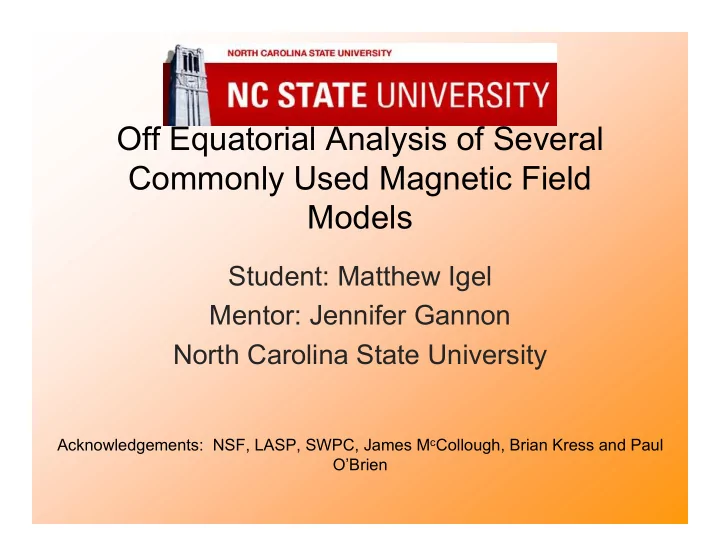

Off Equatorial Analysis of Several Commonly Used Magnetic Field Models Student: Matthew Igel Mentor: Jennifer Gannon North Carolina State University Acknowledgements: NSF, LASP, SWPC, James M c Collough, Brian Kress and Paul O’Brien
Goals • Evaluate various external magnetic field models included in the ONERA-DESP code above and below the equatorial plane • Recommend appropriate potential model validity situations REU Final Presentation 7/31/08
Methods • Create visualization techniques to see off- equatorial performance of models • Compare model outputs of | B | to satellite magnetometer measurements • Bin comparison studies by Kp, Dst, and magnetic latitude REU Final Presentation 7/31/08
Some Definitions • Dst = Geomagnetic Equatorial Index – “The Dst index represents the axially symmetric disturbance magnetic field at the dipole equator on the Earth's surface” – Define storm sub-phases REU Final Presentation 7/31/08
Some Definitions • Kp = Geomagnetic activity index – … is a code that is related to the maximum fluctuations of horizontal components observed on a magnetometer relative to a quiet day, during a three-hour interval. – 0 ≤ Kp ≥ 9 REU Final Presentation 7/31/08
Why Does Care ? • Ultimately understanding how these models perform differently will help forecasting models. • Scientific research is still performed with “outdated” models. • Poor off equatorial performance of current models could help to spur the development of new ones. REU Final Presentation 7/31/08
Current Knowledge • Equatorial performance on the noonside and midnightside is often poor (PE < .5) (anomalous B z ) [M c Collough et al 2008]. • Tsyganenko ‘96 is popular but is significantly overstretched on the equatorial plane. • Newer models are more complicated to implement. • Models show decreased dawn and dusk performance at equator [Huang et al 2008]. REU Final Presentation 7/31/08
Magnetic Field Models • Olson & Pftizer “Dynamic” [1988] – Limited input range – Only basic physics View: Noon-midnight plane from Dawn-dusk plane from Equatorial plane from dawn side sun above North Pole REU > Mission Ops
Magnetic Field Models • Tsyganenko ‘96 – Still commonly used • Easy to implement – Equatorial field line over-stretching View: Noon-midnight plane from Dawn-dusk plane from Equatorial plane from dawn side sun above North Pole REU Final Presentation 7/31/08
Magnetic Field Models • Tsyganenko ‘01/“Storm” – Sibling models – “Storm” has no input constraints – First to allow for time dependence View: Dawn-dusk plane from Noon-midnight plane from Equatorial plane from above North Pole sun dawn side REU Final Presentation 7/31/08
Magnetic Field Models • Tsyganenko ‘04 – Newest model available – Increased time dependence – Recently touted as providing the best results at View: the Equator Noon-midnight plane from Dawn-dusk plane from Equatorial plane from dawn side sun above North Pole REU Final Presentation 7/31/08
Drift Shells • Shapes are similar between Olson dynamic Tsyganenko 96 Tsyganenko 01 Tsyganenko 04 models • Magnitudes are variable • Results confirm equatorial findings REU Final Presentation 7/31/08
Satellite Verification of model output | B | Field Polar Cluster http://pwg.gsfc.nasa.g http://clusterlaunch.esa.int/science- ov/polar/ e/www/object/index.cfm?fobjectid=41122 REU Final Presentation 7/31/08
Prediction Efficiency Measures how much variation in the data can be explained by the model. REU Final Presentation 7/31/08
Kp Bins • Divided into… – Low ( 0 < kp < 3) – Medium ( 4 < kp < 6) – High ( 7 < Kp < 9) • Lowest bin shows highest prediction efficiency. • Overall: Tsyganenko ‘04 has highest PE. • High Kp: Tsyganenko ‘01/“Storm” has best PE. REU Final Presentation 7/31/08
Dst Bins (Storm Phases) • Divided into: Positive, Negative, Preliminary Recovery, and Advanced Recovery phases. • Best during Positive and Advanced Recovery • Overall poor early recovery phase results • Tsyganenko ‘04 has best prelim recovery PE probably due to time dependence. REU Final Presentation 7/31/08
Magnetic Latitude • Divided into: 0°-19°, 20°-39°, 40°-59°, >60°. • 0°-19° and 40°- 59° latitude bins show best performance. • >60° bin shows lowest predictive power. REU Final Presentation 7/31/08
Magnetic Latitude Con’t • All three Tsyganenko model perform decently in lowest latitudes. Olson & Pftizer is weakest. • As latitude increases… – Newer models retain robust performance. – Older models drop off in performance. • At highest latitudes, Tsyganenko ‘01 is best. REU Final Presentation 7/31/08
Conclusions Overall • Models perform best in low geomag activity. • Storm time model performance is best during positive and advanced recovery phases of storms. • Many of the problems shown in equatorial studies are manifest at higher L values. • Drift shells are very similar among models. REU Final Presentation 7/31/08
Conclusions Con’t Models • Overall, Tsyganenko ‘04 shows best performance statistics. • During extremely high Kp and at high geomag latitudes, Tsyganenko ‘01 provides best performance. • Tsyganenko ‘96 and Olson & Pfitzer “dynamic” show worst performance. REU Final Presentation 7/31/08
Future Work (for the fall) • Continue to expand the number of data points for better statistics • Submit for Fall AGU conference • Write it up and send if off to Space Weather REU Final Presentation 7/31/08
Wall of Shame REU Final Presentation 7/31/08
Recommend
More recommend